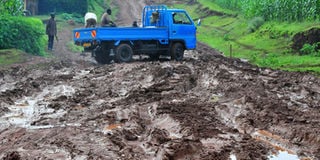Uganda seeks Shs270b for Kapchorwa-Suam road to boost regional trade

During the rainy season, vehicles get stuck at Kapchorwa-Suam road. Sometimes traders use donkeys to transport produce. FILE PHOTO
What you need to know:
Produce. The region produces maize and barley among others
Kampala.
Kenya and Uganda plan to build another corridor to boost trade between the two East African countries.
The proposed road on the Ugandan side will start in Kapchorwa Town through to Bukwo and Suam before joining the Endebess – Kitale - Eldoret bypass roads project in Kenya.
The Suam bridge forms the boundary of Kenya and Uganda in Bukwo District.
Uganda National Roads Authority and the Kenya National Highways Authority are seeking funds from the African Development Bank (AfDB) for the project.
The Ugandan section of the road will cost $80m (Shs270b) with funding expected to come from the Government of Uganda and African Development Bank (AfDB).
The Ugandan section, according to UNRA, will be about 73 kilometres and will be upgraded from the current gravel to tarmac, which will be a relief to various farmers around the Sebei Sub-region.
“It is a very sensitive and vital corridor linking the productive sub-regions of Bugisu, Karamoja and Sebei. It is also another eastern gateway to the neighbouring country of Kenya,” says Eng Joseph Otim, the director road maintenance at UNRA.
The regions are known for the production of maize, barley, sorghum and coffee, among others.
In the rainy season, the road often gets flooded and denies access to goods that could cross from Uganda to Kenya.
“The 35 kilometre of the road on the Kenyan side, and 73 kilometre stretch on Ugandan side is in a poor state which renders it impassable during rainy seasons. AfDB has promised to redesign the road,” Trans Nzoia county governor Patrick Khaemba, told the Business Daily in Kenya. Mr Khaemba said that residents at the Kenyan border are spending a lot of money in Uganda and if the AfDB approves the funding to tarmac the Kitale- Suam highway, economic activities would be spurred.
The AfDB has already completed resettlement plans for the entire road. Additionally, environment and social impact assessment have already been completed.
“The multinational project will support regional integration and cross-border trade with Uganda and Kenya at Suam. The project will contribute to improving road transportation and trade facilitation along the Suam border to foster transport linkage with Kenya, Uganda, South Sudan and Democratic Republic of Congo (DRC),” reads the Environment and Social Impact Assessment for the road project.
Currently, procurement for a contractor is ongoing and, according to UNRA, road works will commence in the 2016/17 financial year.
People to be displaced
According to the Resettlement Action Plan (RAP) for the Ugandan section, it is estimated that 2,564 people will be affected by the loss of land and their structures.
The greatest impact will be felt by subsistence and smallholder farmers. The plan also indicates that people who are the rightful owners of the land, under Ugandan land laws, will be entitled to compensation.
“The assets that will be compensated include; loss of physical assets, crops and revenue or income resulting from economic displacement or physical relocation, whether these losses are permanent or temporary,” the RAP reads.
The total cost of compensation and resettlement is projected to be about Shs30b and will be incurred by the government of Uganda.
The numbers
Shs30 billion
The total cost of compensation and resettlement that will be incurred by government.
73 kilometres
The Ugandan section of the proposed highway.




